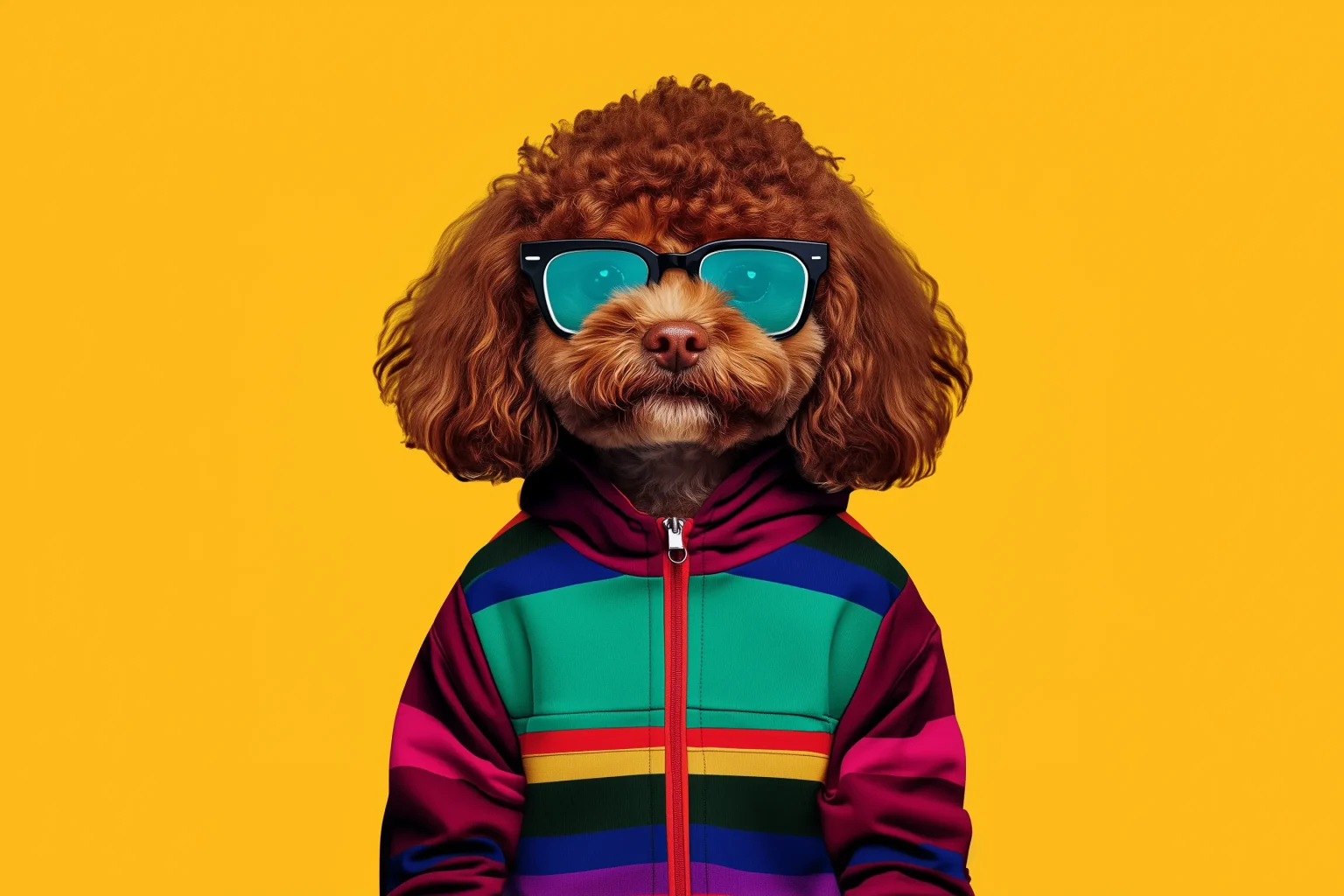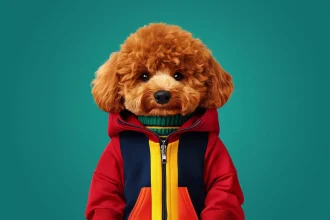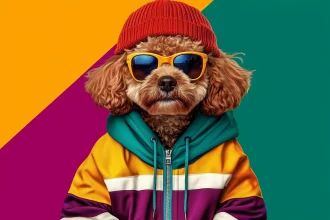According to the American Veterinary Medical Association, nearly 60 million American households now include a dog as a family member – that’s 45.5% of all U.S. homes. Among the fastest-rising stars in urban homes are designer dogs like the Cavapoo. As these Cavalier King Charles Spaniel-Poodle crosses flood social media feeds with their irresistible faces, it’s easy to see why they’ve captured hearts worldwide. But after five years as a professional dog walker, I can tell you there’s much more to these companion dogs than their Instagram popularity.
When my client first told me she was getting a Cavapoo, I honestly thought she’d made up the name. Dozens of Cavapoo clients later, I’ve become something of an accidental expert on these increasingly popular crossbreeds. Between their hypoallergenic coats, friendly nature, and adaptability to different environments, they seem almost too good to be true. But are they? Let’s explore what really matters when considering one of these clever hybrid dogs as your next family pet.
Overview of the Cavapoo
The Cavapoo (American English) or Cavoodle (Australian English) is a popular designer dog breed resulting from a deliberate cross between a Cavalier King Charles Spaniel and a Poodle, typically a Miniature or Toy Poodle. This intentional hybridization aims to combine the gentle, affectionate nature of the Cavalier King Charles Spaniel with the intelligence and low-shedding coat of the Poodle.
While breeders often market these dogs as “perfect family pets” and “hypoallergenic,” I’ve learned to be more realistic with my clients. Yes, many Cavapoos are wonderful with kids and easier on allergies than some breeds, but they’re not magical unicorn dogs. Every Cavapoo I’ve worked with has been unique – some quiet, some chatty, some velcro dogs, others more independent. What they all share is an ability to wrap their families around their little paws.
Historical Background and Origin

The Cavapoo story is pretty recent – they first appeared in Australia in the 1950s, making them practically newborns in the dog breed world. The original breeders were aiming to create the ultimate companion dog, and honestly? They might have succeeded. Within just a few decades, Cavapoos have gone from experimental crossbreed to one of the most sought-after designer dogs worldwide.
Here’s something most guides won’t tell you: there’s still no official breed standard for Cavapoos. This means two important things. First, reputable breeders are working from their own interpretation of what makes a good Cavapoo. Second, appearances and temperaments can vary significantly. I’ve got two Cavapoo clients from the same breeder who could pass for entirely different breeds – one looks like a living teddy bear with tight curls, while the other could easily be mistaken for a purebred Cavalier.
Physical Characteristics
I’ve learned to answer the inevitable question from curious onlookers: “What kind of dog is that?” with another question: “How much time do you have?” Because with Cavapoos, there’s no simple answer. Let me break down what I’ve seen across dozens of these adorable mixed breeds.
Size and Weight
Here’s what breeders often don’t emphasize enough: Cavapoo size can vary significantly. In my experience, most adult Cavapoos fall into these ranges:
- Height: 9 to 14 inches at the shoulder
- Weight: 9 to 25 pounds
The size variation largely depends on whether the Poodle parent was Toy or Miniature, but even within the same litter, you can get surprisingly different sizes.This is why I always tell potential owners to meet both parent dogs if possible and be prepared for some surprises as their puppy grows.
Coat Types and Colors
After countless grooming conversations with my clients, I can tell you that Cavapoo coats are anything but predictable. Here’s what I typically see:
| Coat Type | Characteristics | Maintenance Level | My Notes |
| Wavy and Silky | Medium-length waves, soft texture | Moderate | Most common type I see; tends to mat less than curly but still needs regular brushing |
| Tight Curls | Dense, Poodle-like curls | High | Best for allergy sufferers but requires professional grooming every 6-8 weeks |
| Straight-ish | Smoother coat with slight wave | Low to Moderate | Rare but easier to maintain; may shed more than other types |
As for colors, I’ve seen quite the rainbow:
| Color Type | Varieties | Popularity | My Notes |
| Solid | Red, apricot, cream, black, chocolate | Very Common | Reds and apricots often fade lighter with age |
| Parti | White with any other color | Common | Pattern can vary significantly |
| Tri-color | Black, white, and tan combinations | Less Common | Colors can become more distinct with age |
Distinctive Features
What makes a Cavapoo instantly recognizable? In my years of walking these dogs, it’s their expressive faces that stand out most. They typically have:
- Round, forward-facing eyes that could melt the coldest heart
- Floppy ears that stay close to their cheeks
- A moderately long muzzle (though length varies)
- A body that’s surprisingly sturdy for their size
- A tail that’s usually carried happily upward when they’re excited
But perhaps their most distinctive feature isn’t physical at all – it’s their ability to make eye contact. I’ve had countless moments where a Cavapoo has locked eyes with me in a way that makes me wonder if they understand everything I’m saying. (Sometimes, based on their selective listening, I’m pretty sure they do!)
The thing about Cavapoo features is that they’re like a genetic grab bag – you never quite know what you’re going to get. I’ve seen siblings from the same litter where one has the Cavalier’s signature round eyes and the other has the Poodle’s more almond-shaped ones. This unpredictability is part of what makes each Cavapoo special, but it’s also why you shouldn’t get too hung up on wanting your puppy to look exactly like that cute one you saw on social media.
Temperament and Personality
Cavapoo personalities are as varied as their coat colors. That said, there are some traits I see consistently enough to paint a pretty reliable picture of what you can expect.
Intelligence and Trainability
Let me start with something that often surprises new owners: Cavapoos are sometimes too smart for their own good. Take my client’s pup, Bella, who figured out that if she pretends to see something in the bushes during our walks, she gets an extra few minutes of sniffing time.
Here’s what I’ve observed about Cavapoo intelligence:
| Trait | Real-World Examples | What This Means for Owners |
| Problem-Solving | Can figure out treat puzzles, open unlatched gates, manipulate toys | Need plenty of mental stimulation to prevent boredom |
| Learning Speed | Usually pick up basic commands in 5-10 repetitions | Keep training sessions short or they’ll get ahead of you |
| Memory | Remember routines, people, and training from months ago | Consistency is crucial – they’ll remember both good and bad habits |
| Adaptability | Quick to understand different situations and adjust behavior | Great for families with varying schedules but can also learn unwanted behaviors quickly |
Affectionate and Playful Nature
I’ve rarely met a Cavapoo that wasn’t a natural-born charmer. Their affection level is typically off the charts – expect a velcro dog that wants to be part of everything you do. Most of my Cavapoo clients will follow their owners from room to room, always ready for the next cuddle session or play opportunity.
Their play style is what really sets them apart. They seem to have an innate ability to match their energy to their playmate’s. I’ve watched the same Cavapoo gently play with a toddler in the morning and then have a spirited game of fetch with a teenager in the afternoon. They’re enthusiastic without being overwhelming, which makes them great companions for families with different energy levels.
What’s particularly endearing is how they combine play with affection. Many of my Cavapoo clients will bring their toys to their favorite humans, not just to play, but almost as a gift – an invitation for connection. Just be prepared for those puppy-dog eyes when they want attention; they’ve mastered the art of the gentle guilt trip.
Adaptability and Family-Friendly Traits
The chameleon-like adaptability of Cavapoos is impressive, but it comes with some important caveats. While they can adjust to various living situations – from quiet apartments to busy family homes – they still have their limits. I’ve noticed they handle schedule changes pretty well, though they definitely thrive on routine. Most can roll with the punches when it comes to different energy levels in the household, but they do best when they know what to expect.
What’s fascinating is how they navigate family dynamics. While they typically get along with everyone, many Cavapoos will choose their special person. This doesn’t mean they ignore other family members – far from it. Instead, they seem to develop different relationships with each person. With one client’s family, their Cavapoo seeks out the teenager for play, the mom for cuddles, and the dad for training sessions. It’s like they understand everyone’s role in their life.
That said, this adaptability isn’t automatic. It requires early socialization and consistent boundaries. The most well-adjusted Cavapoos I work with are those whose families understood that their sweet, adaptable nature needs to be nurtured through proper training and socialization, not just assumed.
Behavior Tendencies
After years of supervising countless dog park interactions and family visits, I’ve gotten pretty familiar with how Cavapoos typically behave in different situations. Let me break it down based on who they’re interacting with.
With Other Dogs
Watching Cavapoos at the dog park is endlessly entertaining. They tend to be the social butterflies of the canine world, but with their own unique style. Most Cavapoos I work with play what I call the “diplomatic game” – they’re friendly with everyone but remarkably good at reading the room.
Take my client’s Cavapoo, Charlie. He’s mastered the art of approaching grumpy old dogs gently, while matching the enthusiasm of playful puppies. It’s like watching a skilled party host work the room. When meeting new dogs, they typically start with a cautious friendliness, often using play bows and other calming signals. They can get overwhelmed by very large or boisterous dogs, but generally, they navigate group settings with surprising grace.
What’s particularly interesting is how they behave with regular playmates. Once they’re comfortable, their playful nature really shines through, though many develop clear preferences for certain play styles or personalities.
With Owner
Remember what I said about Cavapoos being smart? Well, they use those smarts to figure out their humans’ patterns and preferences with almost scary accuracy. Most Cavapoos I know have their owners completely figured out – from knowing which family member is most likely to share their breakfast to understanding exactly what time everyone should be home.
They form deep bonds, but it’s not always the overwhelming clinginess people expect from small dogs. Instead, it’s more like having a very attentive roommate who happens to be really invested in your daily routine. They’ll follow you around, sure, but they’re usually just as happy to be in the same room as they are to be in your lap.
Strangers: Approachability and Caution
Here’s where breeding really shows through. Most Cavapoos inherit a blend of the Cavalier’s friendliness and the Poodle’s alertness, making them generally good with strangers but not naively so. I’ve noticed they typically go through a quick assessment process – first an initial alert (usually just a head tilt or ear perk), then a quick look to their owner for cues, followed by a friendly approach if all seems well.
What’s interesting is how they adjust their greeting style based on the stranger’s behavior. They’re usually more reserved with people who come on too strong and more outgoing with those who let them make the first move. I had one Cavapoo client who would politely ignore overeager greeters but would practically drag me toward people who were calmly minding their own business.
Kids: Temperament Around Children and Safety Considerations
After watching numerous Cavapoo-kid interactions, I can say they’re generally excellent with children, but there are some important nuances. They seem to instinctively know to be gentler with toddlers while being more playful with older kids. However, this doesn’t mean they should be left unsupervised with children.
The real magic happens when Cavapoos interact with kids who know how to respect their space. I’ve watched countless times as a Cavapoo patiently lets a child figure out gentle petting, or cleverly moves away when play gets too rough instead of showing any aggression. They’re remarkably forgiving of accidental rough handling, but they shouldn’t have to be.
The biggest challenge I’ve seen isn’t usually with the dog – it’s with teaching kids appropriate behavior. Even the most patient Cavapoo needs respect for their space and regular breaks from play. I always tell my clients with children that supervision isn’t just about safety; it’s about teaching both the dog and the kids how to interact appropriately with each other. When this balance is struck right, the bonds that form are truly special.
Health and Care
After five years of walking dogs, I’ve learned that a Cavapoo’s teddy bear looks can mask some serious health considerations. Here’s what you really need to know.
Common Health Considerations
Like most designer breeds, Cavapoos can inherit health issues from both parent breeds. The most common issues I’ve seen in my clients’ dogs are heart problems from the Cavalier side and eye issues from both lineages. Knee problems (luxating patellas) show up frequently enough that I’ve learned to spot the early signs – a skipped step here, a bit of hesitation there.
Watch out for:
- Heart valve issues (particularly mitral valve disease)
- Eye problems like cataracts and progressive retinal atrophy
- Knee issues (luxating patella)
- Syringomyelia (a serious neurological condition from the Cavalier side)
- Hip dysplasia (especially in larger Cavapoos)
Life Expectancy
Most Cavapoos live between 12-15 years, though I’ve known several who lived past 16 with good care. The healthiest ones I’ve met came from breeders who did thorough health testing on their parent dogs. Regular vet care makes a huge difference – my client’s Cavapoo just celebrated his 14th birthday and still has the energy of a much younger dog.
Keep in mind that factors like diet, exercise, and dental care play crucial roles in their longevity. I always tell my clients that those routine vet visits, while expensive, are worth every penny for catching potential issues early.
Grooming Needs and Shedding
That adorable coat needs serious maintenance. Skip regular grooming and you’ll end up with matting that requires shaving – I’ve seen it happen too many times. Most Cavapoos need:
- Professional grooming every 6-8 weeks
- Home brushing 2-3 times weekly (daily for curlier coats)
- Regular ear cleaning to prevent infections
- Nail trimming every 2-3 weeks
Exercise Requirements
Cavapoos have moderate exercise needs. Most of my clients do well with:
- Two 20-30 minute walks daily
- Some indoor play time
- Interactive games for mental stimulation
The trick is consistency. They’re adaptable enough to handle occasional lazy days, but they can get destructive if under-exercised regularly. I’ve seen enough chewed baseboards to know the difference between a well-exercised Cavapoo and a bored one.
Training and Socialization
I’ve learned one crucial thing: their intelligence can work for you or against you. Here’s what really matters.
Importance of Early Training and Socialization
Start early. Really early. Those first few months shape your Cavapoo’s future personality more than you’d think. My most well-adjusted Cavapoo clients all had owners who prioritized early socialization. They met different people, encountered various sounds, and experienced different environments before they were four months old.
Cavapoos can be sensitive souls. One bad experience can stick with them. I had a client whose Cavapoo got startled by a skateboard at 12 weeks old – it took months of careful desensitization to get him comfortable with wheeled objects again.
Recommended Training Methods
Forget harsh corrections – they shut down faster than a computer during a power outage. These dogs thrive on positive reinforcement, but they’re also smart enough to manipulate it. Case in point: my client’s Cavapoo learned that sitting pretty got her treats, so she started throwing random sits into every interaction.
The key to successful Cavapoo training:
- Keep sessions short (5-10 minutes max)
- Use high-value rewards
- Stay consistent with commands
- Focus on praise and positive reinforcement
- Incorporate training into daily routines
Behavioral Traits and Training Challenges
Let’s talk about some behavior problems I’ve encountered with Cavapoos. First up: separation anxiety. These dogs bond deeply, and without proper training, that attachment can become problematic. Several of my clients had to work specifically on alone time training from day one.
Barking can be another issue. That Cavalier heritage means they can be alert barkers, while the Poodle smarts mean they quickly learn that barking gets attention. The trick is teaching them when barking is appropriate – not eliminating it entirely.
House training usually goes smoothly, but they can be stubborn about going out in bad weather. One of my clients solved this by teaching her Cavapoo to use a covered area of their patio – genius move for rainy days.
The most successful Cavapoo owners I know treat training as an ongoing conversation, not a one-and-done deal. They’re constantly reinforcing good behaviors and gently redirecting unwanted ones. It’s not about achieving perfection; it’s about building a solid foundation of communication and trust.
Cavapoo Working Roles and Abilities
While Cavapoos are primarily bred as companion dogs, their intelligence, trainability, and gentle nature make them suitable for various roles beyond being loving family pets. These versatile dogs can excel in several activities and even some working capacities.
Adaptive Roles
Cavapoos, with their friendly temperament and adaptable nature, can serve in several roles:
- Therapy Dogs: Their gentle and affectionate nature makes Cavapoos excellent candidates for therapy work. They can provide comfort and emotional support in hospitals, nursing homes, and schools.
- Emotional Support Animals: Cavapoos’ intuitive and empathetic nature allows them to excel as emotional support animals for individuals dealing with anxiety, depression, or other mental health challenges.
- Reading Dogs: Some Cavapoos participate in programs where children read to dogs to improve their reading skills and confidence. The non-judgmental presence of a calm, attentive dog can be very encouraging for young readers.
- Small Space Companion: Their moderate size and adaptable nature make Cavapoos ideal companions for apartment dwellers or those living in smaller spaces.
It’s worth noting that while Cavapoos can excel in these roles, they are not typically used as service dogs for tasks requiring larger, stronger breeds.
Abilities in Specific Tasks or Sports
Despite their small size, Cavapoos can participate and excel in various dog sports and activities:
- Agility: Their intelligence and agility make them good candidates for dog agility courses, where they can navigate obstacles and follow handler commands.
- Obedience Trials: Cavapoos’ eagerness to please and high trainability allow them to perform well in obedience competitions.
- Rally: This dog sport combines elements of obedience and agility, suiting the Cavapoo’s versatile nature.
- Nose Work: Cavapoos can enjoy and excel in scent detection games and competitions, tapping into their natural curiosity and intelligence.
- Trick Training: Their quick learning ability makes Cavapoos excellent candidates for learning and performing an array of impressive tricks.
While Cavapoos may not be working dogs in the traditional sense, their versatility allows them to adapt to various roles and activities. Whether serving as a comforting presence in a therapy setting or showing off their skills in a dog sport, Cavapoos demonstrate that they’re more than just cute faces.
Adoption and Breeding
After watching dozens of families welcome Cavapoos into their homes, I can tell you there’s no single “right” way to find your perfect match. But there are definitely some wrong ways – and I’ve seen the heartbreak that comes with those. Let me share what really matters when deciding between adoption and breeding.
Choosing a Reputable Breeder
If you’re going the breeder route, here’s what you absolutely need to look for – and I’m speaking from both professional experience and watching my clients’ journeys.
A reputable breeder should check all these boxes:
- Health Testing: They should conduct thorough health tests on both parent dogs, especially heart checks for the Cavalier parent.
- Transparency: Good breeders practically overwhelm you with information about their breeding practices and health clearances.
- Living Conditions: The breeding facility should be clean, and puppies should be raised in a home environment, not kennels.
- Limited Breeding: Watch out for breeders who always have puppies available – responsible ones limit their litters.
- Ongoing Support: The best breeders I know still text with their puppy families years later.
- Detailed Contract: Expect health guarantees and spay/neuter requirements in writing.
- Parent Access: At minimum, you should meet the mother dog to understand potential temperament.
Reputable breeders should interview you as much as you interview them. One of my clients got turned down by a breeder because their work schedules didn’t align with puppy care – and honestly? That breeder did them a favor.
Considerations for Adopting from Shelters or Rescue Organizations
While finding a Cavapoo in a shelter is about as rare as a sunny Portland winter, breed-specific rescues can be goldmines. When you go the adoption route, you’ll find dogs of all ages – from energetic puppies to dignified seniors. I especially love placing adult Cavapoos with first-time dog owners since they often come with basic training already in place. And don’t overlook the seniors – I’ve seen these sweet older pups thrive in quieter households where they can spend their golden years being properly spoiled.
The adoption process itself is pretty thorough, which is actually a good thing. While background stories can vary widely (I’ve met rescue Cavapoos who came from everything from loving homes that could no longer keep them to puppy mill shutdowns), reputable rescues do their homework. They typically handle all initial health checks and vaccinations before adoption. Many even provide ongoing support – I’ve seen rescue organizations help with training issues months after adoption.
Don’t be put off by home checks – they’re not about judging your housekeeping skills. I’ve watched these assessments help match dogs perfectly with their new environments. Plus, many rescues offer trial periods, which I think is brilliant. One of my clients discovered during their trial period that their resident cat absolutely adored their potential Cavapoo – that sealed the deal for everyone involved.
Living Conditions for Cavapoos
Cavapoos are known for their adaptability, making them suitable for various living situations. However, like all dogs, they have specific needs that should be met to ensure their happiness and well-being.
Suitability for Apartment Living
Let me bust a myth right away: small dog doesn’t automatically mean apartment-ready. That said, Cavapoos genuinely do well in apartments, mainly because they’re more interested in being near their humans than having a huge space to roam.
I’ve got several apartment-dwelling Cavapoo clients who are living their best lives in modest spaces. One particularly clever client turned their narrow hallway into an indoor fetch runway – this pup gets more exercise than some dogs with yards! The key is creativity and consistency. These dogs need regular mental and physical stimulation, regardless of square footage.
However, there’s one apartment challenge you should know about: barking. Cavapoos can be chatty, especially when they hear hallway noise or see activity through windows. Early training is crucial here – my most successful apartment Cavapoo clients all mastered the “quiet” command before their first birthday.
Compatibility with Other Pets
One of the things I love most about Cavapoos is watching them interact with other pets. They’re generally fantastic with other animals, though like any dog, proper introductions matter. Some of my favorite success stories involve Cavapoos in multi-pet households.
Take my client’s Cavapoo, Luna, who lives harmoniously with two cats. She figured out exactly how much space her feline siblings need and respects it completely. That said, those hunting instincts can kick in with smaller pets. I always tell clients with rabbits or guinea pigs to supervise interactions carefully, no matter how gentle their Cavapoo seems.
The best multi-pet success stories I’ve seen started with careful introductions and maintained clear boundaries. It’s not about hoping pets will get along – it’s about actively managing their interactions until they develop their own comfortable dynamic.
Adaptability to Different Climates
Cavapoos are pretty resilient when it comes to weather, but they definitely have their preferences. These dogs can handle most climates, but they need some help at the extremes.
In cold weather, their coat provides decent insulation, but many of my clients’ Cavapoos appreciate a good sweater during winter walks. Just watch out for snow between their paw pads – those little feet can get uncomfortable quickly in icy conditions.
Heat is actually the bigger concern. Those cute, fluffy coats that keep them warm in winter can make summer challenging. I’ve learned to schedule my Cavapoo walks for early morning or evening during hot spells, and I always carry water, even for short walks. The curlier the coat, the more prone they are to overheating.
The most important thing I’ve learned about Cavapoos and living conditions? They’re incredibly adaptable, but they’re also dependent on their humans making good choices for them. Whether it’s an apartment or a mansion, cold climate or hot, they can thrive anywhere – as long as they get enough attention, exercise, and protection from extreme conditions.
Common Cavapoo Mix-Breeds and Related Crosses
Just when you think you’ve got all the doodle breeds straight, someone shows up with a “Cavapoochon” at the dog park. After five years of walking these designer mixes, I’ve learned one thing: these crosses can get complicated fast. Let me break down what I’ve actually seen out there on the trails.
Overview of Popular Cavapoo Mixes
Sometimes a Cavapoo gets mixed with another breed, creating what I like to call “designer dogs 2.0.” Here’s what I’ve encountered in my walks:
| Mix | Characteristics | Size | Coat |
| Cavapoo-Labrador Mix (Cavapoochon) | Friendly, energetic, intelligent | Medium to large | Vary from wavy to curly, often low-shedding |
| Cavapoo-Maltese Mix (Cavapoo-Tese) | Small, affectionate, playful | Small to medium | Soft and silky, can be low-shedding |
| Cavapoo-Shih Tzu Mix (Cava-Tzu-Poo) | Friendly, adaptable, loving | Small to medium | Slightly wavy to curly, often requires regular grooming |
Other Popular Poodle and Cavalier King Charles Spaniel Mixes
Let’s talk about the cousins in the family tree. I’ve worked with quite a few of these mixes, and they each have their own quirks:
Poodle Mixes:
| Mix | Parent Breeds | Characteristics | Size | Coat |
| Labradoodle | Labrador Retriever + Poodle | Intelligent, friendly, often good with families | Medium to large | Usually curly or wavy, often low-shedding |
| Goldendoodle | Golden Retriever + Poodle | Affectionate, smart, typically good with children | Medium to large | Can be wavy or curly, often low-shedding |
| Cockapoo | Cocker Spaniel + Poodle | Playful, loving, generally good with families | Small to medium | Usually curly or wavy, often low-shedding |
Cavalier King Charles Spaniel Mixes:
| Mix | Parent Breeds | Characteristics | Size | Coat |
| Cavachon | Cavalier King Charles Spaniel + Bichon Frise | Gentle, affectionate, typically good with children | Small | Soft and silky, can be wavy or straight |
| Cavaton | Cavalier King Charles Spaniel + Coton de Tulear | Friendly, adaptable, generally good-natured | Small | Soft and fluffy, often low-shedding |
| Cava-Tzu | Cavalier King Charles Spaniel + Shih Tzu | Affectionate, playful, usually good with families | Small | Silky and often long, requiring regular grooming |
While these breed descriptions are helpful, they’re more like guidelines than guarantees. I’ve met shy Labradoodles and independent Cavalier mixes. The most important thing isn’t the breed mix – it’s matching the individual dog’s personality and needs to your lifestyle.
One of my favorite clients put it perfectly when someone asked about her mixed breed:
“I stopped trying to figure out what she is and just focused on who she is.”
Wise words for anyone considering one of these designer breeds.
Female vs Male Cavapoos
After walking both boys and girls for years, I can tell you that personality matters way more than gender. That said, there are some funny patterns I’ve noticed between the males and females on my route. Let me break it down based on real experience, not just breed guides.
Physical Differences
The size difference between male and female Cavapoos is noticeable but not dramatic. Males typically stand between 12-16 inches and weigh 13-25 pounds, while females are slightly more delicate at 10-14 inches and 10-20 pounds.
What’s interesting is how these differences show up in real life. One of my clients has brother-sister Cavapoos from the same litter, and while the boy is definitely stockier with bigger paws, their size difference isn’t as pronounced as their personalities. The male has a slightly broader face and more muscular build, but you might not notice unless you saw them side by side.
As for their coats? There’s absolutely no difference. That gorgeous Cavapoo fluff is equal opportunity, and I’ve seen stunning coats on both boys and girls. The maintenance level and texture have more to do with which parent they take after than their gender.
Temperamental Differences
Here’s where things get interesting. I’ve noticed some consistent patterns – though there are always exceptions. Male Cavapoos tend to be the class clowns of the family. They’re the ones who’ll learn to ring the doorbell for attention or bring you every single toy they own when you’re trying to work.
Females, on the other hand, often have a more refined approach to life. They’re equally loving but usually more strategic about it. They’ve mastered the art of the subtle hint when they want something, rather than the boys’ approach of throwing themselves into your lap.
When it comes to training, both genders are quick learners, but they often have different styles. Males tend to be enthusiastic but distractible – they’ll master a new trick in minutes but might forget it entirely if they spot a squirrel. Females often show better focus and consistency in training sessions. I’ve noticed they’re usually the ones excelling in advanced obedience work.
Social behavior is another area where I’ve seen differences. Male Cavapoos are often making friends with everyone they meet. Females tend to be more selective about their friendships, often forming stronger bonds with fewer dogs. It’s like watching the difference between an extrovert who loves every party and an introvert who prefers meaningful one-on-one connections.
Making Your Choice
After years of experience, here’s my real-world advice: if you want a perpetual puppy personality who wears their heart on their sleeve, you might prefer a male. They tend to stay playful longer and are usually more affectionate. If you’re looking for a more independent dog who matures faster and shows more focus in training, a female might be your better match.
But here’s the most important thing I’ve learned: these are just tendencies, not rules. My most independent Cavapoo is actually a male, and one of my most clingy clients is a female. I always tell people to meet the actual puppy or dog if possible. The right personality match matters way more than whether you choose a boy or girl.
Both genders are equally wonderful with kids – I’ve seen countless patient pups of both sexes expertly handle toddler hugs and preschooler enthusiasm. The bottom line? Pick the pup whose personality clicks with yours. Gender differences in Cavapoos are subtle enough that individual personality trumps all those generalizations every time.
Funny Facts and Quirks About Cavapoos
After five years of walking these lovable goofballs, I’ve collected enough funny stories to write a comedy series. Let me share some of the most entertaining quirks I’ve observed in my Cavapoo clients.
The Invisible Something
Nearly every Cavapoo I walk occasionally stops to stare intently at absolutely nothing. They’ll freeze, ears perked, head tilted, completely focused on what appears to be thin air. After five years, I’m convinced they’re either seeing ghosts or they’re just really committed to getting a break during walks. Either way, it never fails to make me laugh.
Professional Blanket Burrowers
I’ve never met a Cavapoo who doesn’t think they’re part mole. They don’t just lie under blankets – they engineer complete cave systems out of throws, pillows, and anything else they can find. One of my clients actually had to start making her bed differently because her Cavapoo, Cooper, created such elaborate tunnel systems every day.
The Raindrop Dance
For dogs that supposedly don’t shed much, they sure hate getting wet. Most of my Cavapoo clients treat rain like it’s acid falling from the sky. They’ll do this hilarious high-stepping dance to avoid puddles, then somehow manage to find the muddiest spot in the yard for their bathroom break.
Selective Hearing Experts
Cavapoos have incredibly selective hearing. They can detect a cheese wrapper being opened from three rooms away, but somehow go completely deaf when you call them to come in from the yard.
The Food Critics
Cavapoos can be hilariously picky eaters – but only when it suits them. They’ll turn their nose up at premium dog food but somehow manage to find and eat a dropped piece of popcorn from three days ago in record time. One of my clients had to start feeding her Cavapoo in a maze bowl because he’d inhale his food so fast he’d get hiccups.
The Sock Obsession
What is it with Cavapoos and socks? They don’t necessarily chew them – sometimes they just collect them. One of my clients followed her Cavapoo, Milo, one day and found his secret sock stash behind the couch. He had fifteen socks, all carefully arranged, not a single one chewed. When she confronted him about it, he just tilted his head as if to say, “What? I’m helping with laundry!”
These quirks make each Cavapoo unique and endlessly entertaining. Just when you think you’ve seen it all, they’ll surprise you with some new silly behavior that reminds you why these dogs are so special.
My Final Thoughts on Cavapoo Breed
Five years of professional dog walking has taught me more about Cavapoos than any breed guide could cover. Between the early morning walks, afternoon play sessions, and countless “just one more treat” negotiations, I’ve gotten to know these clever little dogs inside and out. Let me share what really matters.
The Real Deal on Cavapoos as Family Dogs
Cavapoos are basically emotional support animals who never got the official certification. They’re the dogs who somehow know your kid had a rough day at school before you do. The ones who make friends with the grumpy neighbor who “doesn’t like dogs.” The pups who figure out that Grandma needs a gentle walking partner while the teenagers want a playmate for fetch.
I’ve seen these dogs thrive everywhere from studio apartments to sprawling homes, with singles, couples, families, and retirees. That adaptability is real, not just marketing hype.
The Honest Truth About Care Requirements
The grooming isn’t optional. That gorgeous coat needs regular maintenance, or you’ll end up with what one of my clients calls “the matted mess emergency makeover.” Budget for professional grooming every 6-8 weeks, and get friendly with your brush in between.
Training matters more than most people think. Yes, they’re smart and eager to please, but that doesn’t mean they train themselves. Every well-behaved Cavapoo I know got that way through consistent work, not magic.
They need their people. A lot. If your schedule keeps you away from home for long stretches, you’ll need to factor in dog walkers or daycare. Trust me on this – I’ve seen what happens when these social butterflies get too lonely.
Cavapoos are fantastic dogs for people who want a truly involved relationship with their pet. They’re not independent enough to be left alone all day, not low-maintenance enough to skip the groomer, and not simple enough to go without training. But if you’re ready to put in the time, money, and effort they need?
Choose a Cavapoo if you’re ready for a dog that will insert itself into every aspect of your life – and make most of those aspects better. Just don’t say I didn’t warn you about the grooming bills.
Frequently Asked Questions About Cavapoos
A Cavapoo needs two 20-30 minute walks daily plus indoor playtime. These designer dogs have moderate energy from both Poodle and Cavalier King Charles Spaniel heritage. They enjoy fetch, interactive toys, and mental stimulation games. Without proper exercise they develop destructive behaviors, especially in apartments.
Cavapoos require professional grooming every 6-8 weeks and home brushing 2-3 times weekly for wavy coats or daily for curly coats. Their high-maintenance coat needs regular attention to prevent matting. Professional services include trimming, bathing, nail care, and ear cleaning to maintain their appearance.
With proper care, Cavapoos typically live 12-15 years. These companion dogs benefit from regular veterinary care, proper nutrition, and exercise. Their life expectancy depends on factors like genetics from breeding programs, dental care, diet quality, and overall health maintenance throughout their lives.
These affectionate dogs need significant daily interaction as they’re bred specifically as companion dogs. Cavapoos can develop separation anxiety if left alone too long. They require regular playtime, training sessions, and social interaction to maintain their happy, balanced temperament and playful personality.
Research reputable breeding programs or consider pet adoption through rescue organizations. Verify health clearances, meet parent dogs if possible, and evaluate the puppy’s temperament and living conditions. Avoid decisions based solely on social media popularity or Instagram influencers.













